
 by Amber Reimondo, Energy Director
by Amber Reimondo, Energy Director
“If you can’t fly, run; if you can’t run, walk; if you can’t walk, crawl; but by all means keep moving.”
–Martin Luther King Jr.
For those of us who care deeply about the Grand Canyon, we know the journey to permanently protect it from the threats of nearby uranium mining is long and arduous and that we’re far from finished. We also know that’s no reason to stop. Positive change doesn’t come easily, but the Grand Canyon is too important to give up on. We’re in this to win it whether it’s in this Congress or the next.
The long road ahead is also why right now, we’d like to pause and celebrate a milestone. Last week, the long fight to permanently protect Arizona’s worldwide wonder from the threats of new uranium mining saw a victorious step forward. After months of hard work by a broad community of Grand Canyon supporters and numerous tribal nations, the U.S. House of Representatives voted 236-185 to pass the Grand Canyon Centennial Protection Act! The bill, once passed by both houses of Congress and signed by the president, would make the current temporary ban on new uranium mines on about 1 million acres of public lands around the Grand Canyon permanent.

On the House floor ahead of the vote, Arizona Reps. Raúl Grijalva, Tom O’Halleran, Ann Kirkpatrick, and Greg Stanton implored their colleagues to vote in favor of the bill. Between them, they cited the problem of unplanned mine flooding at the north rim Pinenut Mine and the south rim Canyon Mine, the threat that Canyon Mine may pose to the Havasupai Tribe, the extensive existing legacy of uranium mining contamination in the Southwest, particularly on Navajo lands, and the reality that mining never has been and never could be a primary economic driver in Northern Arizona. In opposition, Arizona Rep. Paul Gosar reiterated his misleading claim that mining uranium is actually good for the environment and the Grand Canyon. That argument grossly ignores the nuanced reality of uranium solubility and insolubility in water and the interconnected nature of ground and surface water in the Grand Canyon region.
As a reminder, for uranium to be dissolvable in water, oxygen must be present, a condition that is inevitably created during the mining process as previously entombed uranium is exposed to the air and hauled to the surface. And scientific research has underscored that groundwater flow is extremely variable around the Grand Canyon, flowing in multiple directions, at varying speeds, and traveling many miles horizontally and thousands of feet vertically from where it started. Uranium mining in the Grand Canyon region is, in no uncertain terms, a gamble of a sacred landscape and a worldwide wonder, and it puts the primary driver of the northern Arizona economy — tourism — at risk.
In the end, 236 members of Congress, including nine Republicans, were persuaded that the risk of uranium mining near the Grand Canyon is simply too great and voted to advance the bill, placing its fate into the hands of the U.S. Senate.
As we wait to see whether the Senate will consider the bill, the president’s Nuclear Fuel Working Group continues to deliberate a list of recommendations which may include lifting the temporary Grand Canyon mining ban and creating taxpayer subsidies for uranium to cushion the bottom lines of mining companies.
In a statement released last week by White House policy advisers, this administration states it “is strongly opposed to” the bill and that the president’s advisers “would recommend that he veto it.” We can’t be sure what will happen until we get there, but for now, we’ll focus on putting one foot in front of the other because the Grand Canyon is, and always will be, too precious to mine.
Onward.
80% of Arizona voters support Baaj Nwaavjo I'tah Kukveni National Monument, according to a new poll.
Read MoreThe Colorado River below Glen Canyon Dam is heating up. Find out why.
Read MoreGroundwater pumping at a uranium mine near the Grand Canyon will affect the canyon's springs, scientists says.
Read More